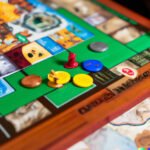The classic Game of Life board has been captivating players for generations with its timeless appeal and enduring charm. This iconic game, first introduced in the 1960s, continues to captivate players of all ages with its unique blend of strategy, luck, and nostalgia. The Game of Life board offers a thrilling journey through various life milestones, allowing players to experience the ups and downs of adulthood in a fun and engaging way.
At its core, the Game of Life is a game of choices and consequences, as players navigate their way through different career paths, make important financial decisions, and ultimately strive to reach retirement with the most wealth. Each twist and turn on the board represents a pivotal moment in life, from getting married and having children to finding success in your chosen profession.
But what makes the Game of Life truly special is its ability to bridge generations. For many, playing this classic board game evokes feelings of nostalgia and sentimentality as they recall fond memories of family game nights or friendly competitions with friends. The colorful design, fascinating components, and engaging gameplay have made it a staple on shelves for decades.
As we delve into the history, gameplay mechanics, intricate design elements, strategies for winning, cultural impact, unique variations, collectors’ editions, and more related to the Classic Game of Life Board in this article series; one thing becomes abundantly clear – this beloved game continues to captivate players young and old with its enduring charm. So gather your loved ones or friends around the table – it’s time to step into the world of the Classic Game of Life Board.
History
The history of the classic Game of Life board game dates back to the late 19th century. The game was originally created by Milton Bradley, an American game designer and entrepreneur, and was first introduced to the public in 1860 as “The Checkered Game of Life.” However, it wasn’t until 1960 that the game achieved immense popularity and became a classic.
The early versions of the game differed significantly from the modern iteration. In its earliest form, the game consisted of a simple checkered board with numbered spaces and players were required to move their pieces across these spaces according to a spinner. The objective was to reach the end of the board with the highest amount of money, which helped simulate real-life choices and situations.
Over time, the game underwent numerous changes and additions. In 1960, Reuben Klamer redesigned The Game of Life to incorporate a spinning wheel instead of a spinner, allowing for smoother movement around the board. Additionally, Klamer added more elements inspired by real-life experiences such as education paths, career choices, marriage decisions, and raising families.
Since then, there have been several re-releases and special editions of The Game of Life that reflect changing cultural values and trends. For example, various versions have been released that focus on different aspects such as careers like teaching or farming, or adaptations based on popular franchises like Harry Potter. These variations have allowed players to engage with familiar themes while still experiencing the timeless appeal that has made The Game of Life so beloved.
Overall, understanding the origins and evolution of The Game of Life showcases how it has adapted alongside societal shifts throughout history while still remaining true to its core concept. This is what makes it a truly iconic board game that continues to captivate audiences today.
Gameplay
Setting Up the Game
To begin playing the classic Game of Life board, gather two to four players and set up the game board in the center of the playing area. Each player should choose a colored car pawn and place it on the starting point on the board.
Additionally, players should receive a specific amount of money, depending on the number of players, as their starting funds. The bank should also be stocked with enough money for all players to make transactions throughout the game.
The Turns and Actions
The gameplay of the classic Game of Life board is turn-based, with each player taking their turn clockwise around the board. The first player spins the wheel and moves their car pawn forward the number of spaces indicated by the spin. As they land on different spaces, they follow instructions that either involve earning or spending money, or making decisions that could affect their future turns.
Throughout the game, players will encounter various spaces such as Career Spaces, College Spaces (if they chose to go to college), Payday Spaces (where they collect money from jobs or investments), and Action Spaces that prompt actions like getting married or buying a house. These spaces can have positive or negative effects on a player’s finances and overall progress in the game.
Winning and End of Game
The objective of playing the classic Game of Life board is to accumulate as much wealth as possible by strategically navigating through life choices and financial opportunities. Players must make decisions about pursuing higher education for better career prospects, choosing whether to get married or stay single, investing in properties for passive income, and managing unexpected expenses like accidents and taxes.
The game typically ends when all players have reached retirement age on the board. At this point, each player adds up their accumulated money from careers, investments, and other sources throughout gameplay. The player with the highest net worth becomes the winner of this classic board game.
Gameplay in the classic Game of Life board offers an engaging experience where players can simulate various life scenarios and make decisions about their financial future. By understanding the rules and strategies involved, any player can enjoy an exciting journey through this timeless game.
Components
The Classic Game of Life Board is known for its intricate design and the carefully crafted components that make up the game. Each element of the board, from the colorful paths to the player tokens, contributes to the overall gameplay experience.
At the center of the Classic Game of Life Board is the iconic spinning wheel, which determines players’ moves and adds an element of chance to the game. The wheel is divided into different sections, each corresponding to a number on the board. Players take turns spinning the wheel and moving their tokens along the designated spaces.
The game board itself features a winding path filled with various spaces and landmarks. Throughout their journey, players encounter spaces that represent different life events such as getting married, having children, buying a house, and even unexpected twists like paying taxes or receiving windfalls. These events add excitement and unpredictability to gameplay.
In addition to the spinning wheel and game board, the Classic Game of Life also includes small plastic pegs as player tokens. These pegs come in various colors and are used to mark each player’s progress along the path. Each player starts with a specific amount of money, represented by colorful play money bills that hold different denominations.
Overall, it is clear that much thought and attention went into designing each component of the Classic Game of Life Board. From its engaging spinning wheel mechanism to its detailed game board layout and vibrant components, every aspect of this classic game contributes to its enduring appeal.
| Component | Description |
|---|---|
| Spinning Wheel | The centerpiece of the game that determines players’ moves. |
| Game Board | A winding path filled with spaces representing different life events. |
| Player Tokens | Small plastic pegs used to mark each player’s progress. |
| Play Money Bills | Represent the players’ amount of money in different denominations. |
Strategy
The Classic Game of Life Board is not just a game of chance; it also requires careful strategic thinking to come out on top. Here are some tips and strategies to help you master the art of winning at the Classic Game of Life Board:
- Set Clear Goals: Before you start playing, think about what your ultimate goal is in the game. Do you want to accumulate the most wealth? Have the biggest family? Or maybe retire with the highest number of life points? Having a clear objective in mind will help you make decisions throughout the game that align with your goal.
- Make Wise Career Choices: One of the most crucial decisions in the game is choosing a career path. Each career comes with its own advantages and disadvantages, so consider which profession will best support your goal. For example, if your objective is to accumulate wealth, then choosing a high-paying career like a doctor or lawyer may be beneficial.
- Invest Wisely: Throughout the game, you’ll have opportunities to invest in various assets such as houses and stocks. It’s important to analyze these options carefully and invest in those that will provide a good return on investment. Keep an eye on other players’ choices as well because sometimes investing strategically can mean taking advantage of their moves.
- Plan for Retirement: As you near retirement age in the game, start planning for it ahead of time. Accumulate enough money and life points to retire comfortably and ensure that your retirement space on the board is filled with higher value tiles.
- Pay Attention to Other Players: It’s essential to keep an eye on what other players are doing during the game. Pay attention to their chosen career paths, investments, and life events as these can affect your own strategy. Sometimes adjusting your plans based on their actions can give you a competitive edge.
By following these strategies and adapting them to suit your own gameplay style, you can improve your chances of winning at the Classic Game of Life Board. Remember, the key is to always think ahead and make decisions that align with your goals. So, gather your friends or family, learn from your victories and defeats, and enjoy the challenge of mastering this timeless classic.
Nostalgia
The Classic Game of Life Board holds a special place in the hearts of many individuals, as it is more than just a source of entertainment-it serves as a nostalgic portal back to simpler times. For those who grew up playing this iconic board game, it conjures fond memories of family game nights, gathering around the table for hours of laughter and friendly competition.
In today’s fast-paced digital world, where screens dominate our attention, revisiting the Classic Game of Life Board offers a refreshing escape into nostalgia.
The Power of Nostalgia
Nostalgia has a unique ability to transport us to a different time and evoke strong emotions. The simple act of holding the colorful spinner or moving our token along the intricately designed board sparks feelings of joy, excitement, and innocence. The Classic Game of Life Board was initially released in 1960, and for many players, it serves as a tangible connection to their childhoods and the shared experiences with loved ones.
Reconnecting with Loved Ones
Playing the Classic Game of Life Board today allows individuals to not only reconnect with their past but also with their loved ones. It provides an opportunity to gather friends or family members for an evening filled with laughter and reminiscing.
As players take turns navigating through career choices, buying homes, getting married, and starting families on the board, conversations often veer towards personal anecdotes and cherished memories from real-life experiences. This game bridges not only generations but also fosters deeper connections among players.
Escaping from Digital Overload
In an era dominated by technology and screen-time overload, playing the Classic Game of Life Board offers a much-needed break from digital distractions. With its tactile components and face-to-face interaction required between players, it brings people together in a way that smartphones and tablets cannot replicate. The game promotes genuine engagement, social interaction, and quality time spent with loved ones-reminders of a simpler era when digital distractions were not yet dominant.
Playing the Classic Game of Life Board is more than just reliving fond memories; it allows for new memories to be created, connections to be strengthened, and the joy of life’s journey to be celebrated. Through its nostalgic charm, this classic board game continues to capture the hearts of players young and old, reminding us that sometimes the most simple and traditional forms of entertainment can have the greatest impact.
Variations
The Classic Game of Life Board has not only stood the test of time, but it has also inspired a variety of unique and interesting variations. These adaptations offer a refreshing twist on the classic gameplay, allowing players to experience the game in new and exciting ways.
One popular variation is the “Junior” version of the Game of Life. This edition is designed for younger players, usually ages 5 and up. It simplifies the gameplay and introduces elements that are more suitable for children, such as career cards like “Ice Cream Taster” or “Superhero.” The Junior version also includes vibrant illustrations and a shorter playing time, making it more accessible and engaging for young players.
Another notable variation is the “Electronic Banking” edition of the Game of Life. In this version, traditional paper money is replaced with electronic banking units that keep track of each player’s finances digitally. This modern twist adds convenience to gameplay while maintaining the essence of managing finances throughout life’s ups and downs.
In recent years, themed versions of the Classic Game of Life Board have become increasingly popular. Players can now find variations based on beloved TV shows, movies, or even iconic destinations. For example, there is a Harry Potter-themed edition where players attend Hogwarts School of Witchcraft and Wizardry while navigating life choices along the way. These themed versions add an extra layer of excitement by immersing players into their favorite fictional worlds.
Whether you’re playing with little ones using the Junior version or delving into a fantastical realm with a themed edition, these variations provide endless fun and entertainment for fans of the Classic Game of Life Board. They offer new challenges and experiences that keep the game fresh and appealing to both loyal fans and newcomers alike.
Some notable variations include
- Junior version: simplified gameplay for young players
- Electronic Banking edition: replaces paper money with digital banking units
- Themed versions: based on popular TV shows, movies, or destinations.
These variations not only offer different gameplay experiences but also make great additions to any board game collection. Whether you’re looking for a version suitable for children, a modern adaptation with electronic banking, or an immersive themed edition, there is undoubtedly a variation of the Classic Game of Life Board out there that will capture your interest and provide hours of enjoyment.
Cultural Impact
The Classic Game of Life Board has had a significant cultural impact and has left a lasting legacy in the world of pop culture. Since its creation, the game has made appearances in various forms of media and has become ingrained in the collective consciousness of society.
One notable example of the game’s cultural impact can be seen in film and television. The Classic Game of Life Board has been featured or referenced in numerous movies and TV shows, often serving as a symbol of nostalgia or as a representation of life’s ups and downs. It is not uncommon to see characters playing the game on screen, highlighting its enduring popularity and recognition.
In addition to its presence in visual media, the Classic Game of Life Board has also influenced other aspects of popular culture. For example, references to the game can be found in music lyrics, books, and even video games. Its iconic spinner device and unique gameplay have become synonymous with the concept of navigating through life’s milestones and making decisions along the way.
To further analyze the influence and legacy of the Classic Game of Life Board in pop culture, it is interesting to look at its impact on social dynamics. The game provides players with a platform for social interaction, strategic thinking, and decision-making skills. Its inclusion in family gatherings, parties, and game nights has contributed to its widespread popularity and cultural significance.
| Media | Examples |
|---|---|
| Film | The Truman Show (1998), Daddy Day Care (2003), Friends (TV show) |
| Television | Stranger Things (TV show), How I Met Your Mother (TV show), Parks and Recreation (TV show) |
| Music | “The Game of Love” by Santana ft. Michelle Branch, “Love Me Like You Do” by Ellie Goulding |
Collector’s Editions
The Classic Game of Life Board has a rich history that spans several decades, leading to the creation of various collector’s editions that have become highly sought after by enthusiasts. These special editions offer unique designs, updated components, and limited availability, making them valuable additions to any game collection.
One popular collector’s edition is the “Vintage” version, which replicates the original 1960 board game. This edition appeals to those who value nostalgia and enjoy experiencing games in their original form. The Vintage edition features retro-style artwork, vintage-inspired components, and even comes in a replica of the classic box. It offers players a chance to relive the early days of playing the game and appreciate its timeless appeal.
Another notable collector’s edition is the “Deluxe” version, which takes gameplay to a whole new level with its luxurious design. This edition typically features a high-quality, wooden game board with premium details such as gold foil accents and embossed artwork. The Deluxe version also includes upgraded components like metal player tokens and customized spinner dials. This edition enhances both the aesthetic appeal and tactile experience of playing the Classic Game of Life Board.
In addition to these collector’s editions, there are also themed versions that cater to specific interests or fandoms. For example, there have been collaborations with popular TV shows like Friends or The Simpsons, resulting in special editions featuring characters and locations from these beloved series. These themed editions provide fans with a unique way to engage with both their favorite show and the timeless gameplay mechanics of the Classic Game of Life Board.
Collector’s editions not only add value to individual collections but also contribute to preserving the legacy and cultural impact of this iconic board game. They showcase how this classic game continues to evolve and remain relevant through various iterations that capture different audiences’ interests. Whether it be through vintage designs, deluxe features, or themed collaborations, collector’s editions offer a glimpse into the rich history and enduring charm of the Classic Game of Life Board.
Conclusion
The Classic Game of Life Board has captivated generations with its enduring charm and timeless appeal. This beloved board game has a rich history, evolving over the years to become an iconic staple in the world of gaming. From its humble beginnings to its widespread cultural influence, the Game of Life Board remains a cherished form of entertainment that continues to bring joy and nostalgia to players young and old.
Throughout its history, the Game of Life Board has stood the test of time by adapting to changing interests and preferences. Its gameplay mechanics have remained accessible, yet challenging enough to keep players engaged. The intricate design and components of the board add depth and excitement to each play-through, making every session a unique experience.
One cannot underestimate the impact that the Classic Game of Life Board has had on popular culture. From references in movies and television shows to inspiring real-life career paths, this game has left an indelible mark on society. It is a testament to its enduring charm that even as technology continues to advance, people still find solace and enjoyment in gathering around a table with friends and family to play this classic game.
In conclusion, whether you are a seasoned player or someone discovering it for the first time, the Classic Game of Life Board offers something truly special. Its timeless appeal lies in its ability to bring people together, evoke feelings of nostalgia, spark strategic thinking, and ultimately generate endless fun. As we celebrate the enduring charm of this beloved game, let us remember that sometimes it is those simple moments spent playing around a board that create the most cherished memories.

I love playing all kinds of games – from classics like Monopoly to modern favourites like Ticket to Ride.
I created this blog as a way to share my love of board games with others, and provide information on the latest releases and news in the industry.





